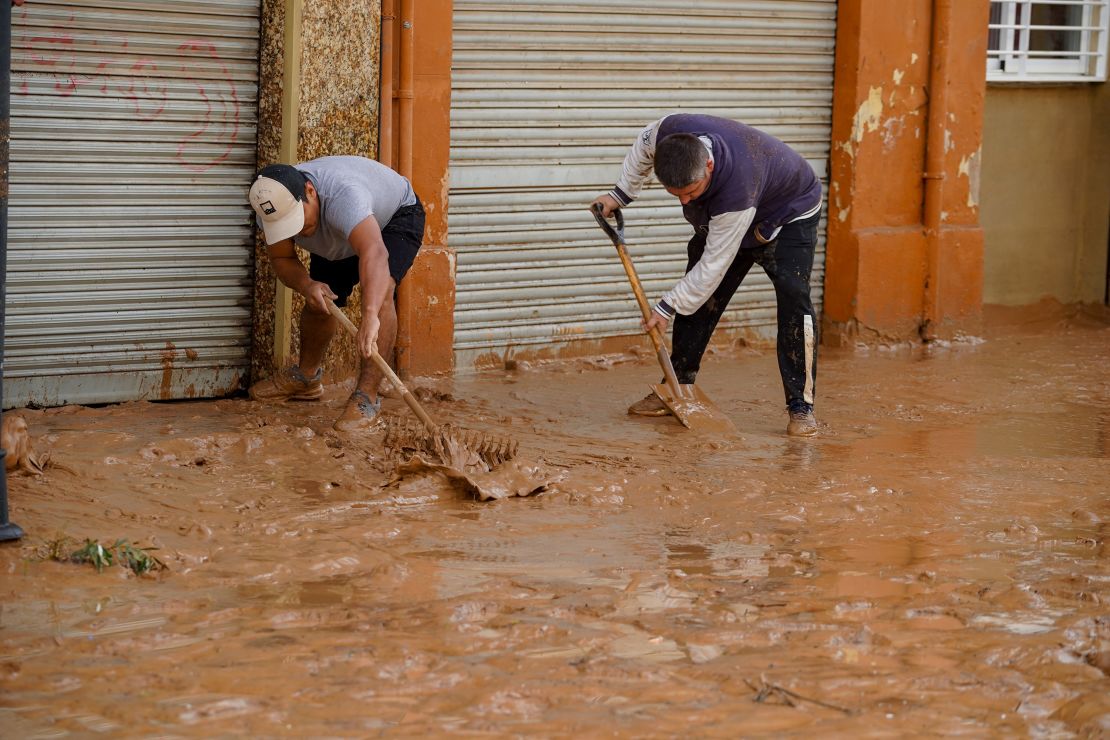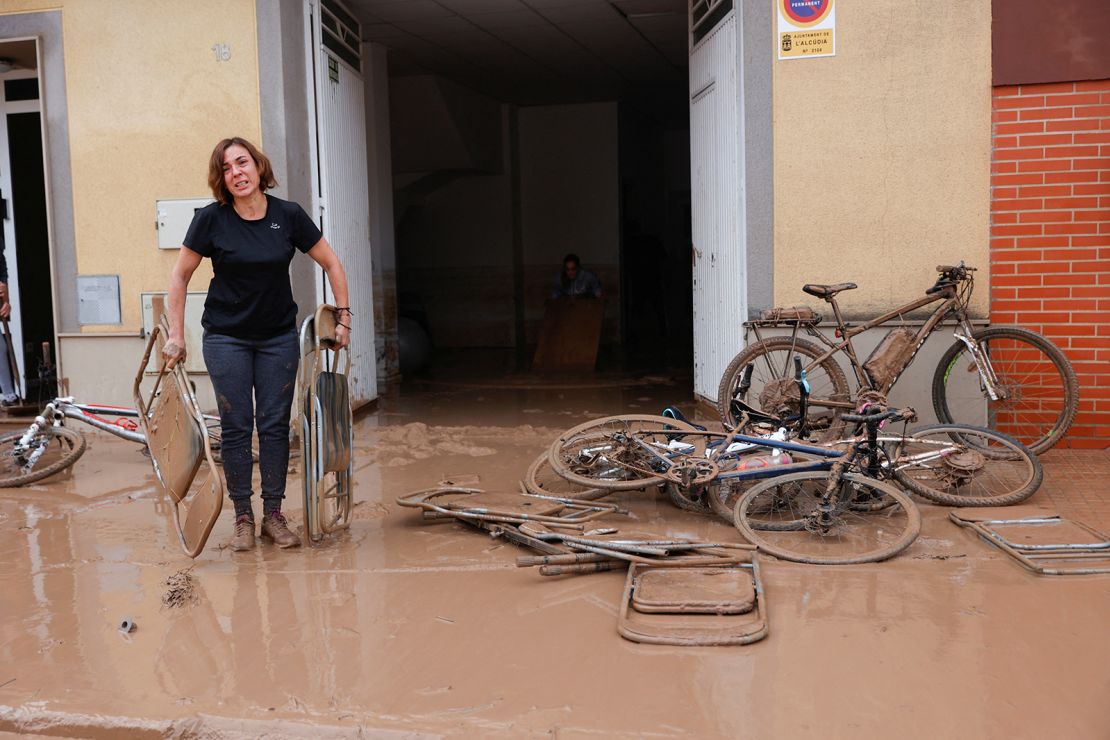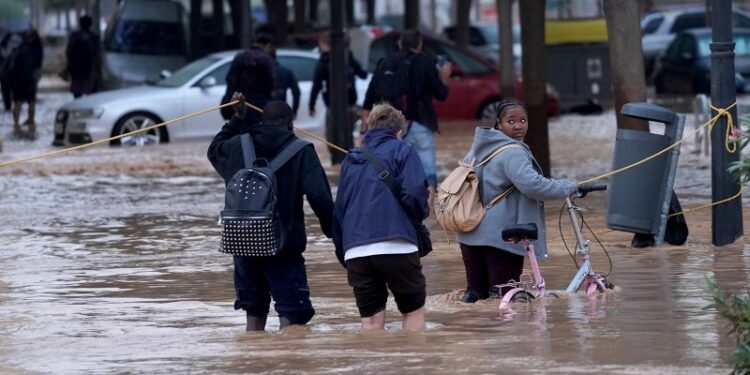At least 95 people have been killed by severe flash floods in Spain, according to authorities on Wednesday, as emergency responders scramble to find dozens of missing people.
In the worst affected region of Valencia, 92 people were killed, according to Angel Victor Torres, Spain’s Minister of Territorial Policy and Democratic Memory. Two others died in Castile-La-Mancha, and one person in Andalusia.
Among the dead is a 71-year-old British man who died from hypothermia in Malaga, according to the city’s mayor, Francisco de la Torre.
Authorities said they are working to identify the victims.
This comes after several locations in southern and eastern Spain received up to 12 inches of rain in just a few hours on Tuesday, in what marked the worst rainfall in Valencia in 28 years, according to state weather agency AEMET.
The Valencia region was thrown into a state of chaos, with most highways becoming completely unusable on Tuesday night and Wednesday morning. Vehicles that had been left abandoned in traffic were picked up by the water and moved around.
Videos posted by several rescue agencies on Wednesday show entire streets flooded, people stuck on rooftops and cars piled up and flipped over. Emergency services in Valencia, the city of Malaga, and Castile-La-Mancha, among other regions, said they were still working on finding dozens of missing people.
Trains between Madrid and the region’s capital, also called Valencia, have been suspended, as have other major public services in other affected regions. Schools, museums, and public libraries in the Valencia region will be closed on Thursday, according to the local government.
Footage from the city of Valencia on Tuesday showed muddy water flooding through the streets, tearing down walls and sweeping away parked cars.
Survivors and family members of the missing spoke to Spain’s national broadcaster, TVE, about the terrifying deluge. “It was agonizing. When we saw the water rising and reaching the first floor of the house we went to the roof,” one resident told TVE. “We stayed on the roof until 4 a.m. [11 p.m. ET Tuesday]. We didn’t have water, we were cold. Finally, the helicopter arrived.”
“Everything is destroyed, but at least we are here to tell [the story],” she added.
Petruta Sandu’s family was also caught off guard by the sudden flooding. She last spoke to her parents late on Tuesday night when they had been trapped on the roof of their car as waters rose around them.
“Since the 10 p.m. last night, we don’t know anything about our parents,” she told RTVE. “My brother-in-law walked almost 7 km [over 4 miles] through knee-deep water to find the helicopter and find the vehicle but they didn’t find anyone. We don’t know where our parents are.”
In towns close to rivers such as Utiel or Paiporta, water spilled onto the streets, CNN en Español reported. Vans, cars and garbage cans were swept away by currents that, in some cases, reached the first floor of buildings.
AEMET reports that the “cold drop” that caused the flooding is the worst Valencia has experienced this century, but adds that it is too early to tell if climate change is to blame. The term “cold drop” refers to a pool of cooler air high in the atmosphere, which can separate from the jet stream, causing it to move slowly and often lead to high-impact rainfall events. The phenomenon is most common in autumn.
The sheer amount of rain that fell meant many were taken by surprise, with people finding themselves trapped in their basements or first floors and unable to get to safety.
Spanish Prime Minister Pedro Sanchez said on Wednesday that his government would use all means necessary to help victims of the floods, as he asked people to remain vigilant. He is set to visit Valencia on Thursday.
Valencia’s regional leader Carlos Mazón told reporters earlier on Wednesday that some bodies were found as rescue teams began to reach areas previously cut off by the floods, adding, “Out of respect for the families we are not going to give any more details.”
Spanish Defense Minister Margarita Robles described the flooding as an “unprecedented phenomenon,” CNN en Español reported. Robles said that more than 1,000 members of the military had been deployed to assist in rescue efforts.
The Spanish government has decreed three days of official mourning for victims of the flooding, starting on Thursday.
Mazón also urged residents in the provinces of Valencia and Castellón to avoid travelling by road.
Residents on Wednesday were facing a huge clean-up and searching for bodies, as well as the threat of more rainstorms.

A local resident from one of the affected towns, Antonio Carmona, described to CNN what happened when the floods hit. “When we looked by here, we saw everything going down. (The water) took cars, it took down half of the house of one of our neighbors.”
Carmona pointed to his torn clothing, saying he and others had been saving dogs caught up in the flooding.
One woman named Beatriz Garrote was driving home from work in the city of Torrent in Valencia on Tuesday evening when she found herself trapped on a stretch of the ring road by the rising water for several hours alongside other drivers, according to Spanish newspaper El Pais.
“I went past the first exit, which was for Paiporta, but it was closed because they told us that the town was flooded there and we couldn’t exit,” she said, El Pais reported. She said her car then got stuck “and suddenly the two lanes closest to the exit started flooding.”
She described feeling “very scared” as water levels rose rapidly. “I didn’t know where it was coming from or what was happening. The water started to rise very quickly.
“After 10 minutes, it was half way up the car’s wheel. One of the volunteers told us to turn the cars around but there was no possible exit.”

The Valencia area averages 77 millimeters (3.03 inches) of rain for the entire month of October.
Chiva, just east of Valencia, received 320 millimeters (12.6 inches) of rain in just over four hours, according to the European Severe Weather Database.
Flooding was also reported in and around the cities of Murcia and Malaga, with more than 100 millimeters (4 inches) of rain falling in some areas.
The human-caused climate crisis is making extreme weather more frequent and more severe, scientists say.
As the world warms due to fossil fuel pollution, the most intense rain events are getting heavier and more frequent. Hotter oceans fuel stronger storms and a warmer atmosphere can hold more moisture which it wrings out in the form of torrential rainfall.
Rainfall warnings continue through Wednesday for portions of eastern and southern Spain, according to Spain’s Meteorological Agency, AEMET, with the threat of heavy rain expected to continue through the end of the week.
This story has been updated with the latest developments.
Source link : https://www.cnn.com/2024/10/30/europe/spain-flash-floods-intl/index.html
Author :
Publish date : 2024-10-30 20:40:00
Copyright for syndicated content belongs to the linked Source.


